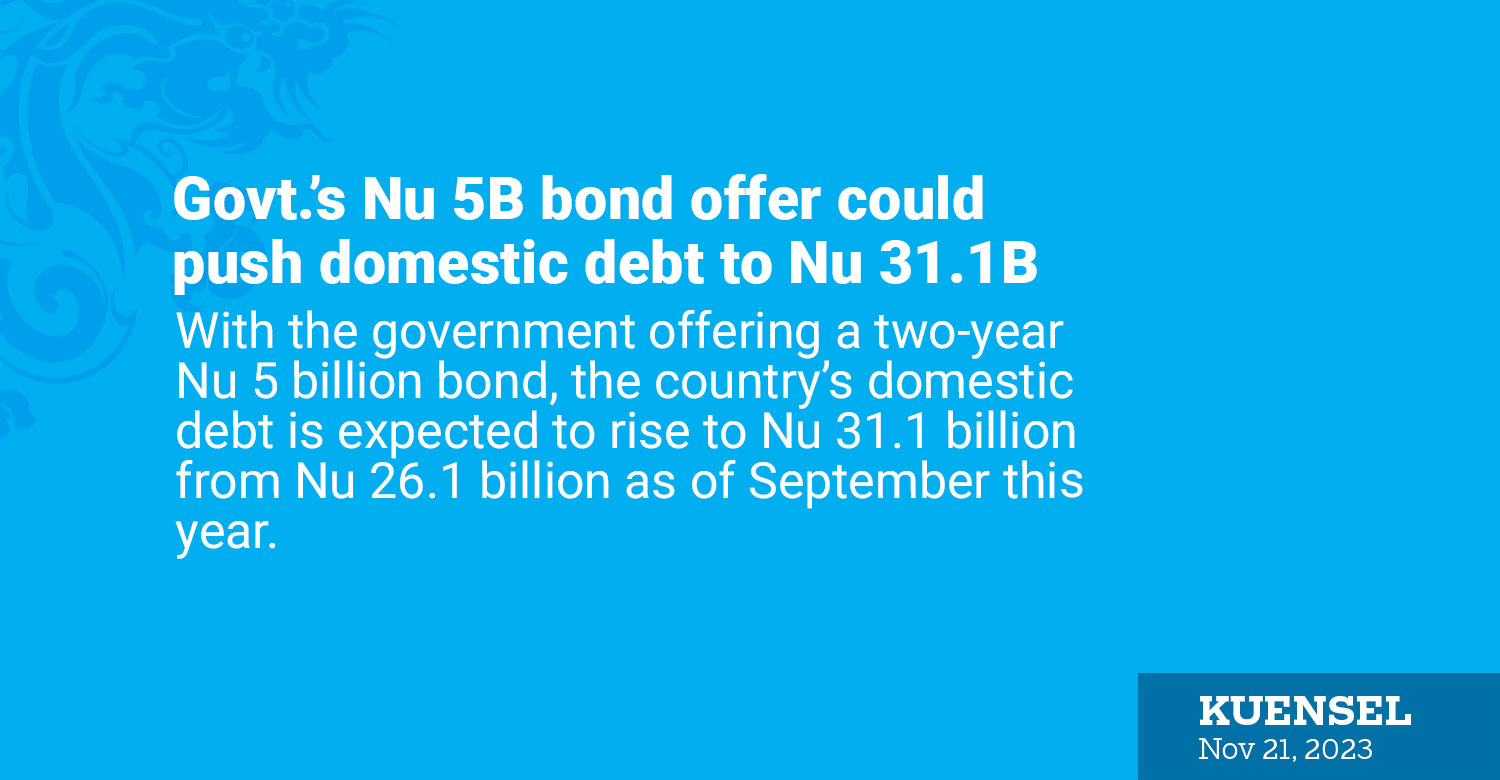Thukten Zangpo
With the government offering a two-year Nu 5 billion bond, the country’s domestic debt is expected to rise to Nu 31.1 billion from Nu 26.1 billion as of September this year.
The domestic debt consists of treasury bill stock of Nu 7.3 billion and government bonds of Nu 18.8 billion, which represents 12.9 percent of the estimated gross domestic product (GDP) or 9.6 percent of the total debt.
On November 17, the finance ministry announced that the submission of subscription applications for the Nu 5 billion bond would be open from November 17 and close at noon on November 24. The allocation will be using a yield-based auction with the coupon rate to be determined in the auction.
This marks the eleventh issuance of bonds by the government, which borrows such debt to cover budgetary shortfalls from both external and domestic financing, with liabilities falling directly to the government.
By buying a bond, subscribers are providing the issuer with a loan. The government agrees to pay back the face value of the loan on a specific date and to make periodic interest payments twice a year and face value on the maturity date.
For the current bond, the ministry will pay the first coupon on May 28, 2024, and the second on November 28, 2024, into the bank account of the bondholder.
The face value of the bond has been fixed at Nu 1,000 and the minimum subscription amount at Nu 10,000 (10 units), and the maximum limit is not been specified. The maturity date is on November 28, 2025, when the principal amount and final interest will be paid.
Interest earned from the bonds is non-taxable for personal income tax. However, the interest income from the bond is taxable (5 percent as tax deducted at source) for business income tax and corporate income tax-paying entities.
The government bonds of Nu 18.8 billion comprises a 10-year government bond of Nu 700 million in February 2021, a 10-year bond of Nu 3 billion in February 2022, a 7-year bond of Nu 1.5 billion in April 2022, a 12-year bond of Nu 4 billion in June 2022, a 10-year bond of Nu 1.25 billion each in January and February 2023 respectively, a 9-year bond of Nu 3.1 billion in May 2023, and a 5-year bond of Nu 1 billion in June 2023.
Most of these bonds mature by 2034 with an annual coupon (interest) rate between 3 and 9 percent. The majority of the subscribers are banks.
According to the Public Debt Policy 2023, the central government debt (external and domestic) should not exceed 55 percent of GDP in any given year.
As of September this year, the central government debt or non-hydro budgetary debt was recorded at Nu 90.6 billion. It comprises 44.8 percent of GDP and is under the debt policy threshold.
At the 2023-24 GDP estimate of Nu 219.51 billion, the government has an additional space of 10.2 percent or Nu 22.39 billion to borrow as non-hydro budgetary debt.
With Bhutan graduating from the least developed countries status to a lower middle-income country in December this year, access to concessional financing from external sources will be limited.
To leverage alternative sources of finance, Bhutan is also developing its sovereign sustainable bond framework with the help of the United Nations Economic and Social Commission for Asia and the Pacific (ESCAP).
The issuance of a sustainability bond in Bhutan could support the country in accelerating its effort to achieve its climate adaptation and mitigation priorities, provide new investment options, and support green job creation.
As per Section 126 of the Public Finance Act 2007, the ministry can borrow money to finance fiscal budget deficits and refinance maturing debt or a loan paid before the redemption date.
The ministry can also issue bonds to maintain credit balances in the bank accounts, and on lending to State enterprises and other legal entities, on-lending to state enterprises and other legal entities, or for any other purposes approved by the Cabinet.


